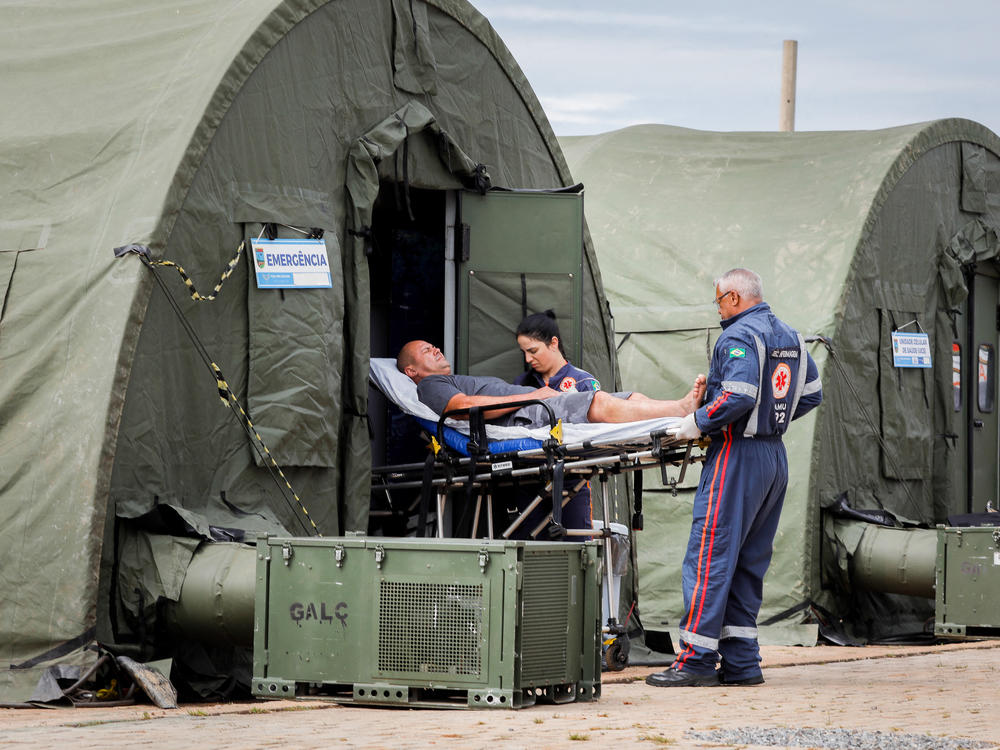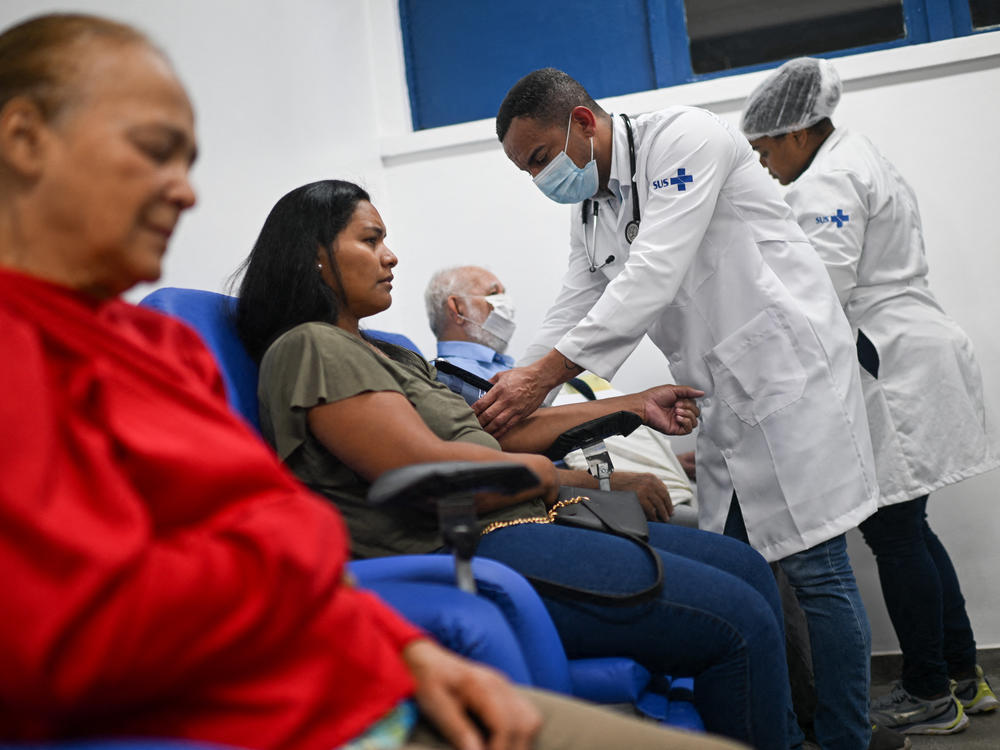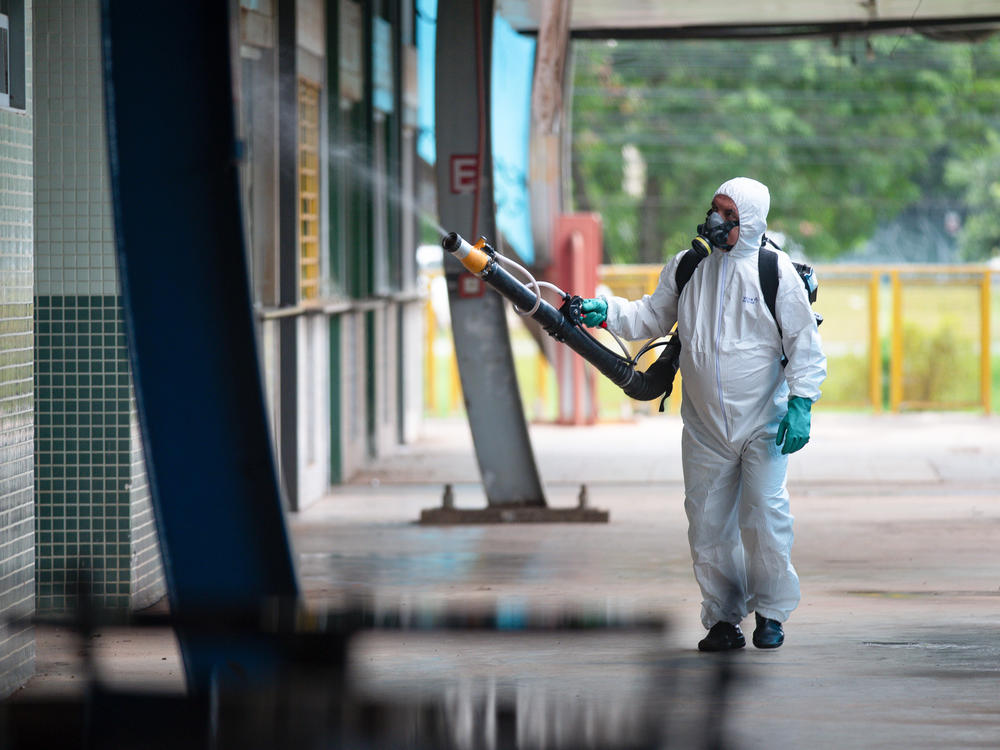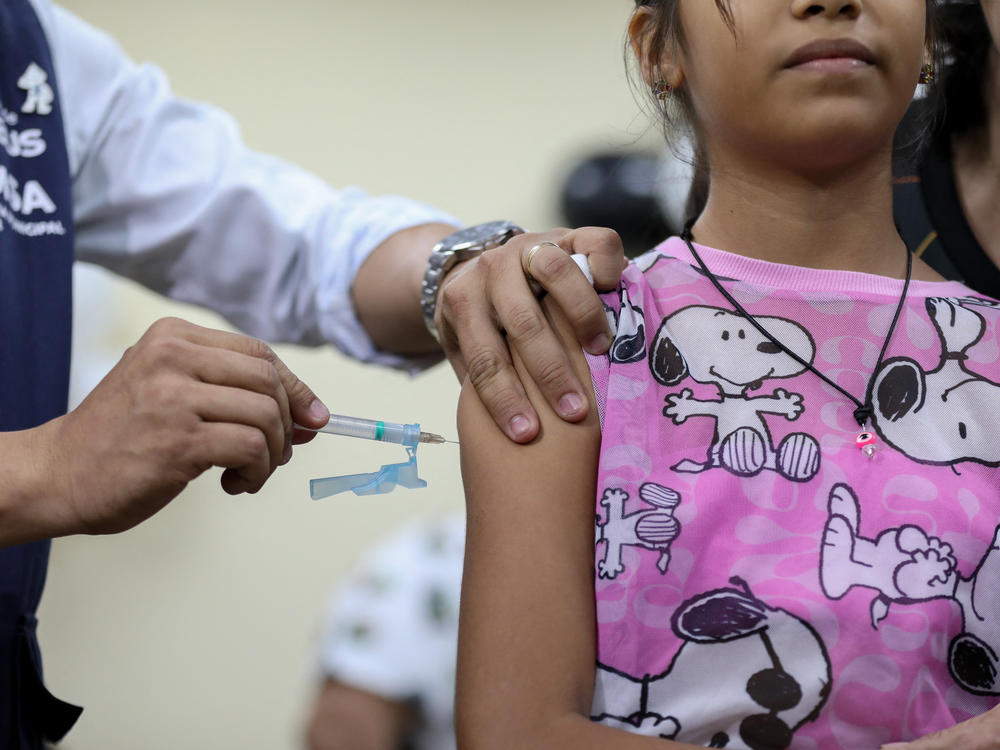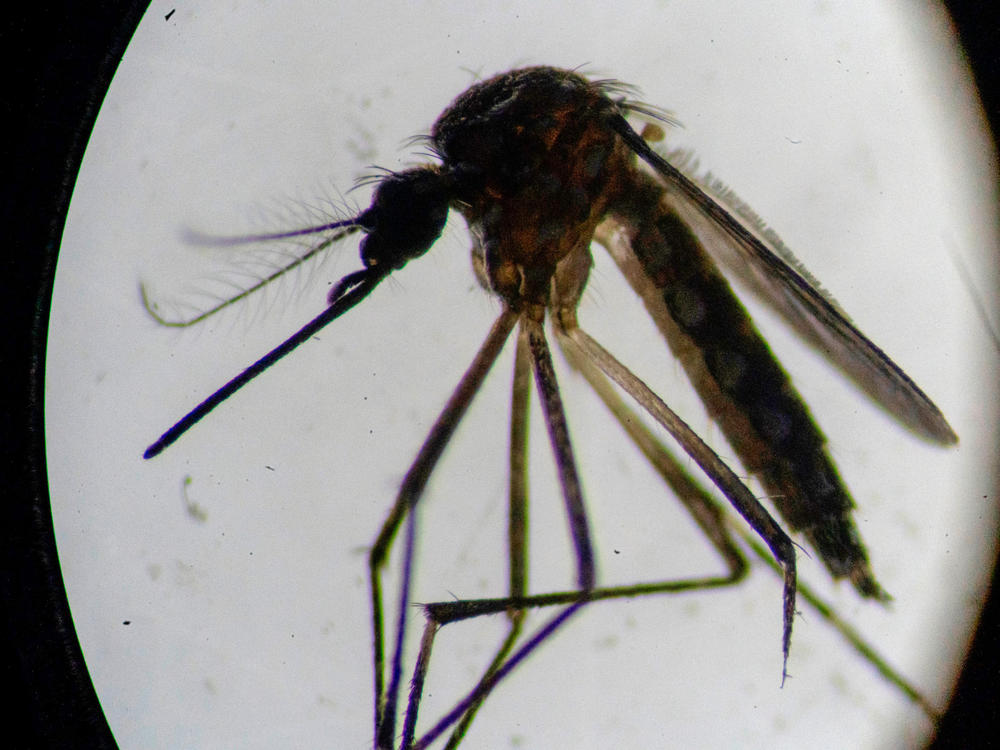Section Branding
Header Content
With a million cases of dengue so far this year, Brazil is in a state of emergency
Primary Content
It was 3 a.m. on Feb. 6 when the dengue field hospital in Brasília temporarily shut its doors.
The generator powering the medical facility had blown and the 29 members of the Brazilian Air Force in charge had to change it before they could see patients again. Medical professionals who'd been trained to care for dengue patients, they expected to attend to up to 600 people with suspected cases per day. In the first 24 hours after the doors opened on Feb. 5, they saw 1,300. The generator couldn't keep up.
As they worked through the middle of the night and into the wee hours of the morning to get power back to the tents set up next to the neighborhood emergency care unit, a new line started to form. By the time the new generator was in place at 8 a.m., some people had been waiting for hours, sitting on the ground in an attempt to stave off dizziness, headache and body aches from a disease so painful it's known as "breakbone fever."
Just two days later, there was an explosion in the number of confirmed dengue cases in the Federal District, where Brasilia is situated. That Brazilian state had issued an emergency decree two weeks earlier because of the havoc the mosquito-borne disease was wreaking on its population. In the midst of an unprecedented dengue outbreak that began in 2022, the Federal District is the Brazilian state most affected this year. By Feb. 17, it surpassed 72,600 confirmed cases — which was the total for all of 2023.
At least six Brazilian states in addition to the Federal District are facing dengue epidemics and 17 cities have declared a state of emergency as the country has already registered 1 million cases of dengue in the first two months of 2024, more than half the 1.6 million cases confirmed last year — which was already almost 18% higher than in 2022. The fatality count in those same two months was 214.
As a result, Brazil's public health-care system, known as SUS, has been grappling to keep up, resorting to field hospitals like the one in Brasília and tents in strategic points around its cities to triage patients with suspected cases of dengue.
While caring for those who are already ill, Brazil continues to tackle prevention with its usual methods: using a fog machine to kill mosquitoes by spraying fine droplets with low concentrations of insecticides mixed with water and running campaigns to remind people how to avoid a bite from dengue-carrying Aedes aegypti mosquitoes (using bug spray, keeping stagnant water out of homes and wearing long sleeves and pants are all helpful), where the species breeds (it's important to remove stagnant water and anything that collects it from homes) and what to do if symptoms arise (don't self-medicate — make sure to see a doctor for diagnosis and treatment).
Brazil's not the only place where dengue is running rampant. Nearby Peru is in the throes of an epidemic. Bangladesh, Nepal, Pakistan, Sri Lanka and Vietnam have also seen dengue spike dramatically. Niger, a subtropical country, reported its first case of the disease in 2022. And in the last year, high-heat states like Texas, Florida and California have seen a smattering of unexpected cases of dengue.
The mosquito-borne viral disease — which causes symptoms like fever, rash, muscle and joint pain in mild cases and can lead to persistent vomiting, bleeding from the gums and nose, difficulty breathing and death when it becomes hemorrhagic — had only occurred in seven countries before 1970. But over the last 20 years, the World Health Organization reports the number of yearly dengue cases has increased by eight times with 100 to 400 million registered worldwide every year. Now, roughly half the world's population is at risk of infection.
Why is dengue making such unprecedented strides?
The answer lies in the method of transmission – and the changing environment of Earth.
Dengue is transmitted to humans in tropical and subtropical climates through the bite of infected female Aedes aegypti mosquitoes. The species prefers to live and breed in urban and semi-urban areas because of its need for human blood in the egg-production process. Those eggs, laid on the surface of stagnant water, can be found in construction sites, tire shops, cemeteries, abandoned swimming pools, plant pots and anyplace else where water collects.
The mosquitoes are thriving in areas where climate change has made temperatures higher and precipitation more abundant than in the past — this species likes it hot and humid. In the last handful of years, migration, urbanization and other socioeconomic issues have also all played a hand in providing ideal conditions for the spread of Aedes aegypti and the dengue it can carry.
So it's not enough to tell people to get rid of standing water and be more fastidious with their use of bug spray. And in its response to this unprecedented outbreak, Brazil has become a test case: experimenting with other interventions to prevent a dengue-ridden future.
A vaccine roll-out
In February, Brazil's public health-care system started rolling out Japan's two-dose Qdenga vaccine — already available on the private market in several countries in Europe, the U.K., Indonesia and Thailand, as well as private and public programs in Argentina — in the country's first attempt to immunize the most vulnerable members of the population against dengue. During clinical trials, the vaccine's efficacy was 80% one year after the second dose was administered.
The Butantan Institute, a biological research center located in São Paulo, is also developing a vaccine to prevent all four variations of the mosquito-borne disease. In its most recent clinical trials, conducted across Brazil from 2013 to 2015, the single-dose vaccine protected 79.6% of those immunized — including both those who have and have not had dengue before.
But dengue vaccines have a controversial history. While Brazil hasn't taken steps to vaccinate its population against dengue until now, the Philippines did attempt to immunize children across the country in 2016. The vaccination campaign went horribly wrong, with at least 10 deaths blamed on the vaccine, which seemed to increase the risk of plasma leakage syndrome, a complication in which blood vessels leak blood's yellow fluid, in children who had never been exposed to dengue before. The tragedy left the population cautious about new dengue vaccines.
But experts are optimistic that safer options are to come.
"The new vaccines are made in a different way, so I would hope they don't have the same effect [as the vaccine used in the Philippines]," says André Siqueira, an infectious-disease expert and febrile-illness researcher at Brazil's Oswaldo Cruz Foundation (Fiocruz) who is not involved in the development of any of the vaccines. "They're very promising. But they need to be strictly observed and monitored."
A mosquito biofactory: infecting them with a bacteria
Other solutions focus on the mosquito. Brazil has been working with the World Mosquito Program for over a decade and, in collaboration with Fiocruz, is building a mosquito biofactory.
The project, called Wolbito, will produce mosquitoes infected with Wolbachia, a bacteria found naturally in the majority of insects (including other types of mosquitoes) but not in Aedes aegypti. When scientists insert the bacteria into the species' eggs, it should have a number of beneficial results.
First, a virus can no longer replicate inside a mosquito born from those eggs — so the mosquitoes can't transmit the dengue virus.
Second, females carrying Wolbachia pass the bacteria on to their descendants, so there's a continuing impact.
And third, any males with it make females they mate with incapable of laying eggs.
When Wolbachia is established in a mosquito population (after scientists release mosquitoes from the factory and plant eggs with the bacteria around a community) it should mean a decrease in incidences of dengue, among other mosquito-borne diseases, according to Neelika Malavige, who is not affiliated with the biofactory and is head of Dengue Global Program and Scientific Affairs at the Drugs for Neglected Diseases Initiative (DNDi).
"The Wolbachia method is one of the best interventions for vector control so far," says Malavige. "Since it's a biological method, the harm to the environment by chemical fogging is eliminated. So far the trials have shown very promising results, but we need to further understand the costs involved in implementing this method in low- and middle-income countries to determine if it's affordable and we also need to better understand how this technology can be transferred to the countries."
When it's ready next year, the mosquito biofactory will be able to produce 400 million Wolbachia eggs a month for Aedes aegypti — the species that can carry and spread not only dengue but also yellow fever, chikungunya and zika.
"The number of dengue cases have shot up," says Luciano Moreira, a senior research scientist at Fiocruz and project lead of the World Mosquito Program in Brazil. "With our biofactory, we project that, in 10 years, we will be able to protect around 70 million people in several cities across Brazil."
Malavige agrees with Moreira that the process might not be quick, but the method has shown promise.
So far, Wolbito has released mosquitoes in five municipalities around the country, with plans to add another six this year. The team of experts first takes two to four weeks to talk to the communities about what it wants to do — and the benefits.
Residents often have a lot of questions. They want to know if the bacteria could contaminate the environment when the mosquito dies (no, when the mosquito dies at the end of its lifespan the bacteria dies with it), if Wolbachia passes to humans when they're bitten (it doesn't) and if the process genetically modifies the mosquitoes (no, their genes stay the same). One downside is an initial increase in mosquitoes when those with Wolbachia join the local population, but that only causes some annoyance because of mosquito bites.
Once they have permission from people living in the community, the scientists take to the streets for four to six weeks, driving or walking around with containers full of Aedes aegypti with Wolbachia to release in strategic points of the city. They also hang open containers of eggs from trees, allowing Wolbachia mosquitoes to hatch in the local habitat.
"It's not a method that allows you to see change from one day to the next," says Moreira. "But it is self-sustaining.
"In some areas of Brazil where we released our mosquitoes more than eight years ago, more than 90% of the population still has Wolbachia."
The project has only been carried out in a handful of Brazilian cities, which is why dengue outbreaks have led to epidemics in many places that don't yet work with Wolbito.
But in the cities where it's been working, the scientists have seen encouraging results. Niteroi, a suburb of Rio de Janeiro, started with Wolbito in 2015 and, just last year, became the first city to release Wolbachia mosquitoes in all of its neighborhoods. According to its secretariat of health, the city has seen a 70% reduction in its number of dengue cases following the implementation of the program (there were 158 cases in 2015 and 55 in 2023) and has not seen a spike during this latest surge.
Sterilized males dropped by drone
Another method being used in Brazil to curb the Aedes aegypti population is the release of male mosquitoes sterilized with nuclear radiation, meaning they can't fertilize eggs.
The males, sterilized at two biofactories in Brazil, are released in the same way as Wolbachia mosquitoes — experts head out on foot and in cars, opening containers in areas known to be Aedes aegypti breeding grounds.
For one company, coming up with a way to distribute sterile mosquitoes more widely was a strategy worth developing.
Called Birdview, the startup originally used drones to release insects that naturally fight agricultural pests, reaching areas of farms that were otherwise difficult to get to and lowering the use of pesticides on crops. Now, it flies drones equipped with insect cassettes into hard-to-reach corners of narrow city neighborhoods. Each of those cassettes, which has a film-covered bottom that slowly opens to release the sterile males, can carry up to 17,000 of them per 10-minute flight that covers roughly 25 acres.
"We're still in pilot mode right now," says Ricardo Machado, engineer and founder of Birdview. "But we're ready and eager to do this in larger areas. And eventually we want to decentralize the process, training local people to fly the drones so that communities can be self-sufficient, the cost can be kept low and jobs can be created."
As the number of cases of dengue across Brazil continues to tick upward, the field hospital in Brasília has gotten its operations under control. But lines of people with suspected cases of dengue continue to be in the thousands, so the Federal District upped the number of individual dengue tents around the city — another way to triage patients that is complementary to the hospital and its permanent health-care units — from nine to 20.
It's a cautionary tale for the world as dengue continues to spread.
"It's not like measles, where you give a vaccine and it's end-of-story," says Malavige. "Look at COVID. We have vaccines, we have drugs, and when things get really bad and there's an outbreak, governments ask people to mask up again. For dengue it's the same. We have to have multiple strategies."
Jill Langlois is an independent journalist based in São Paulo, Brazil. She has been freelancing from the largest city in the western hemisphere since 2010, writing and reporting for publications like National Geographic, The New York Times, The Guardian and Time. Her work focuses on human rights, the environment and the impact of socioeconomic issues on people's lives.
